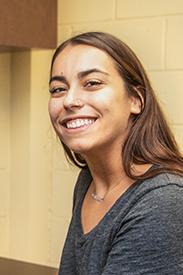National Science Foundation Recognizes Alumni for Neurological Research
By Katherine Haines ’21, ’22
Ariel Kershner ’19 and Kayla Sansevere ’20 received recognition from the National Science Foundation Graduate Research Fellowship Program (NSF GRFP) for their respective neurological research. Kershner was awarded the fellowship for completing research in cognitive psychology studying visual attention, while Sansevere received an honorable mention for her cognitive psychology research.
Ariel Kershner

Image: University of Iowa
Kershner, who studied Biology and Psychology at Arcadia, is a third-year doctoral student at the University of Iowa in the Psychological and Brain Sciences tract in Cognition Studies. Kershner studies the intersection of memory and attention in visual searches and researches categorical cuing—meaning how your memory organizes information to guide visual searches. Kershner has had one paper published and is currently working on two different projects under the NSF grant proposal.
Her first project focuses on categorical cuing through a visual search effect called contextual cuing. Kershner does experiments studying randomly positioned distractor items and a target item that is repeated, which has shown that participants are faster to find the target item when given new distractor items. Additionally, to help understand how the brain uses categories, Kershner changed the features of the target item, like the color and location, and found that the categorical cuing effect with repeated features were found faster than those with non-repeated features.
The second looks at long-term, category-specific effects between trials, suggesting that those effects were strong enough to last long-term. To test this Kershner provided the example of looking at one purple mug, closing your eyes, and when you open them again you’re faster to find the purple mug, but Kershner separates these trials by 36 other trials. The brain is still able to remember the categories that it stores information about for the first trial, after 36 trials, determining that the effects of category-specific memory can last long-term and for many categories.
“The award began this month but I still find it a little hard to believe that I won,” said Kershner. “It feels amazing to be recognized for my hard work in research and service, my potential to advance what we know about attention and memory, and to have this support as I begin my career in cognitive psychology research.”
Kayla Sansevere

Sansevere, who studied Psychology at Arcadia, is a 2nd year doctorate student at Tufts University focusing on Experimental Psychology and cognition. Sansevere’s proposal included her research on attention domains implicated in phubbing behavior, which is when an individual uses their phone as a way to snub another person in in-person interactions (hence: phone snubbing). Sansevere hopes that by identifying the attentional domains implicated in phubbing behavior, the information can be used to complement recent research on the subject that will better inform how and why we engage in this behavior, which can provide important insight for potential interventions. Sansevere is currently working on expanding her NSF GRFP proposal into a Registered Report to submit this summer.
“Being named an honorable mention was very re-affirming for both myself as a researcher overall as well as my research ideas,” said Sansevere. “I know that I see the worth of my research ideas, and my lab advisor and lab members do as well, and it’s really nice knowing that others see that merit, as well.”
Often, research is grant funded and that requires students and researchers to write proposals for the application. Sansevere said that sometimes applying for grants to study psychology topics can make her feel ‘imposter syndrome’ because it teeters between being perceived as a Science, Technology, Engineering, and Math (STEM) subject or not. The NSF GRFP is awarded based on the applicants’ evidence of broader impacts and intellectual merit written in 2 statements: a personal statement that includes past experiences (both cited their research experience from Arcadia), as well as present work and future goals, and a research proposal that can be accomplished in three years. In their statement, applicants need to demonstrate the impact their research will have on the field and how they plan to make people aware.
Both Kershner and Sansevere pointed to their previous experiences and successful applications to things like the Barry Goldwater scholarship (Sansevere) and the Psychology Department’s Martha Jean Hill award for outstanding research accomplishments, which both received.

